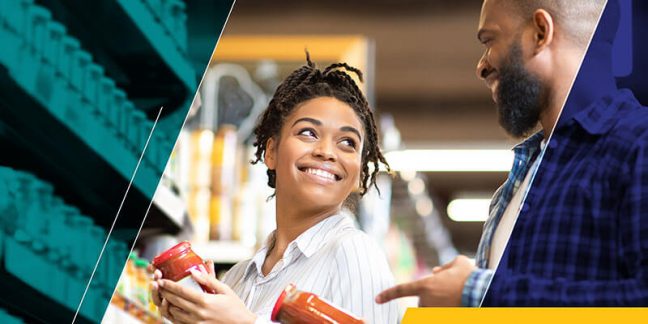Sponsored content
Q&A with Spencer Baird, EVP and president of MarTech Solutions at Inmar Intelligence
Omnichannel seems to be the latest buzzword everyone is talking about. What does it really mean for a retailer, or a brand, and why does it matter?
In any discussions about omnichannel marketing or attribution, it’s useful to start with a reminder that everything we’re talking about here is a result of one common thing – which is shopper needs and the way they’ve changed. Because when you say that, it kind of pulls everybody back down to earth for a second. Forget about fancy terms like omni-this and programmatic-that. The shoppers we’re serving today – whether you’re a brand, a retailer or a third-party partner – have changed. Today’s shoppers expect to be able to shop whenever, however, and wherever they want.
I use the example of old-fashioned, three-channel television versus what people have in their homes, and hands, today. It used to be, you watched whatever was on when it was on. But now it’s consumption on your terms. And so why would retail, and the way we spend 57 to 60 trips – if not 100 trips – a year to a grocery store, or club store or to wherever, why would that be any different? Now, expand that out, away from brick and mortar. Online, on mobile – a customer’s shopping options are almost limitless. So what does that effectively mean for retailers and brands? They have to be everywhere, all at once, in order to meet shopper expectations and needs – or they stand a good chance of missing out not only on a sale, but the chance to build a lasting customer relationship.
What’s driving this omnichannel shift? Why is it happening now?
So we think it boils down to three primary things – cognitive constraints, time constraints and financial constraints. And it just so happens that an omnichannel approach can help alleviate all three of these. First, let’s look at the cognitive. In a world where we’re all struggling to figure out how to deal with the number of things being thrown at us – whether it’s keeping up with social media, the realities of working from home, juggling work and family, COVID, any of it – we really crave clarity and simplicity. So we want to quickly and conveniently find the best values, for the best products, wherever we choose to shop – on mobile, in a store or on our phones WHILE we’re in the store. We want it to feel brainless and painless. Omnichannel can help solve that.
Next on the list is time. Shoppers simply don’t feel like they have enough of it. Ever. And the last thing they want to do is spend valuable time searching for deals, or offers, or even ideas for dinner. They expect all of that to be delivered right to their devices, and they want it personalized to match their purchase history, brand preferences and buying habits. Omnichannel can help solve that.
Finally, we have the financial aspect. The past one to two years haven’t been kind to shopper’s wallets, and that’s putting it gently. Now, as we see prices for almost everything increasing, that financial pressure is growing. Shoppers want retailers and brands to recognize this pressure and proactively offer personalized incentives on the products they use – and buy – consistently. This isn’t about shoppers going out and scouring the internet for deals. It’s about deals coming to them, when they need them the most. Omnichannel can help solve that. And that’s why this seems to be omnichannel’s moment. Convenience, personalization and value are driving everything, and omnichannel is there to deliver all three.
What do you think is holding retailers back from truly embracing an omnichannel focus/approach?
The industry, as a whole, has been confronted with this reality that they must serve shoppers wherever they are in really unique and differentiated ways – which gets back to this combination of convenience, personalization and value. It’s not just about serving their needs in a store, but also on a website, and on mobile, and even at their front door – because you’re now delivering groceries or whatever you deliver – and you have to make all of that unified so it’s one seamless experience for a shopper. That’s challenging. It can be a planning nightmare. Retailers and brands used to just plan for a store experience, which was pretty static. Now? It’s highly dynamic. Retailers and brands need to be intersecting at all those different points because they want to meet people wherever they are, whenever they’re there. As a retailer, I now have to do things in a much more curated, much more intentional, much more technically oriented way.
So that’s what the industry, in a nutshell, is challenged with. How do you plan in a way that creates this great, loyalty driving relationship with the people we care most about in this industry, which is shoppers? And the answer is, you use first-party data to truly understand those shoppers’ needs, create individual plans to meet those needs and build a personalized, omnichannel strategy to stay ahead of those needs. But – and this is really important – this takes more than technology. It takes everyone in the organization speaking the same language, agreeing on a common mission and making sure it’s ultimately all about the shopper.

So, everything is changing and nothing will ever be the same, is that it?
Yes. And no. Shoppers are changing. The way they shop is changing. How we have to adapt is changing. But the fundamentals that drive our business aren’t changing. I think, because we’re all so focused on these tidal shifts in the way we have to plan and focus on shopper needs, we’ve lost sight of the core three metrics that drive sales, that drive units and drive margins. And those three metrics – the number of people you get in your stores (or on your site or your app), how frequently they visit and how much they spend each time they visit – are as rock-solid as ever.
The name of the game in retail today, just like it was 100 years ago, is getting two of those three metrics to work in tandem. You can live beautifully in the world of retail if you’ve got more shoppers and they spend more, or if you have fewer shoppers but they’re coming more frequently and they’re spending more. But there are very few, if any, retail shops in the United States who set targets based on these metrics. Omnichannel tactics are simply new, highly effective ways to go after unique groups of shoppers that should be coming more but they’re not – or unique groups of shoppers that should be spending more but they’re coming less frequently.
With so many initiatives across digital transformation, how can retailers and brands quantify the impact of omnichannel measurement in order to prioritize it?
You can come at the measurement topic from several angles. For me, it’s about continuous improvement. Every company that reports to Wall Street and, frankly, anybody that reports to a board, cares about “percent change versus last year” in everything they do. It’s all about where you were versus where you are. Period. That’s why measurement, attributed sales and attributed results are like the holy grail. And measurement is going to take on a whole new life in the future, in terms of the importance it plays and the role it plays in this world of omnichannel planning. Why? Because it helps retailers, and Retail Marketing Platforms, prove to CPGs that they are the best place to learn what’s working and what isn’t – so together, as partners, they can continuously improve the effectiveness of their incentive and media spends. By collaborating and freely sharing data, these partners can collectively prove they are investing their dollars in exactly the right way. Who wouldn’t make that a priority?

What about the role of automation? Is it really a game changer?
I’m so excited by the role measurement is starting to play in artificial intelligence, machine learning and continuous optimization. There’s a constant stream of signals – data like attributed sales – coming in from the omnichannel activities. Then, in milliseconds, there’s intelligence applied to that data, and adjustments are automatically made on the fly. The learning, and reaction to that learning, is happening almost instantaneously. Forget about getting results in a spreadsheet, having a meeting, planning changes and then implementing those changes. This feedback loop is the future, it’s today, it’s happening now. When we show our customers just how quickly this automated loop can dramatically impact attributed sales – and I’m talking about days, not months or even weeks – it’s like they’ve seen magic. Only it’s real.

Learn more about how Spencer Baird and his team at Inmar are helping retailers develop and execute their omni-channel initiatives through Inmar’s Retail Cloud, powered by the ShopperSync CDP platform.
Spencer Baird, EVP and president of MarTech Solutions at INMAR Intelligence, leads the division that delivers solutions in the areas of Retail Commerce Platform, Media and Data to speed the industry’s digital transformation and meet escalating consumer demand for personalized, targeted digital marketing and messaging to reach, motivate and build relationships. Baird has more than 18 years of executive leadership experience in grocery retail, e-commerce and Consumer Packaged Goods with some of the best known and most respected companies in the industry. Learn more about Baird on our Experts page, here.


